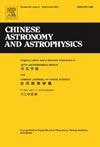The Variations in the Sky Brightness of Lijiang and Namco throughout the Day
Q4 Physics and Astronomy
引用次数: 0
Abstract
The sky brightness is an important parameter to evaluate the excellence of a coronal observatory, which directly determines whether the coronagraph can measure and monitor the coronal activity for a long time. The Sky Brightness Moniter (SBM) is a precision instrument for accurately measuring important atmospheric parameters such as the sky brightness, water vapor content, and atmospheric extinction. It is also an universal instrument for coronagraph site selection and an important equipment for solar site selection in western China. Before conducting statistical analysis on the accumulated data from Namco, this paper first performs an in-depth analysis using representative data from Namco and Lijiang. The aim is to preliminarily study and understand the characteristics of the sky brightness at the site based on the profiles of the representative data. Firstly, by considering the actual climatic characteristics and the normalized sky brightness, the paper gradually explains the different variations of the sky brightness throughout the day. Secondly, we establish an effective calculation method to measure and reveal the evolution characteristics of the sky brightness. The results show: 1) The sky brightness (green line, 530 nm) at the Lijiang station with an altitude of 3200 meters and the Namco site with an altitude of 4700 meters are both relatively good. The minimum values can reach the order of , ensuring the feasibility of regular corona observations. 2) The sky brightness at the Namco site and the Lijiang station evolves differently over time. The Lijiang station is not suitable for all-day observations, with morning conditions being far superior to those in the afternoon. In contrast, the Namco site has a longer observation time (from 9:00 AM to 4:00 PM), and its cooperation with the observation equipment of other stations can significantly improve the efficiency of space weather ground monitoring. The analysis results not only provides a sample analysis for subsequent statistics on the sky brightness at Namco but also demonstrates the expected characteristics of the sky brightness at Namco.
丽江和纳木错全天天空亮度的变化
天空亮度是评价日冕观测台优劣的重要参数,直接决定日冕仪能否长期测量和监测日冕活动。天空亮度监测仪(SBM)是一种精确测量天空亮度、水蒸气含量、大气消光等重要大气参数的精密仪器。它也是日冕仪选址的通用仪器,也是中国西部地区太阳能选址的重要设备。在对南梦宫积累的数据进行统计分析之前,本文首先对南梦宫和丽江的代表性数据进行了深入分析。目的是根据代表性资料的剖面图,初步研究和了解该站点的天空亮度特征。首先,结合实际气候特征和归一化天空亮度,逐步解释了全天天空亮度的不同变化。其次,我们建立了一种有效的计算方法来测量和揭示天空亮度的演变特征。结果表明:1)海拔3200 m的丽江站和海拔4700 m的南梦错站的天空亮度(绿线,530 nm)都比较好;最小值可达10×10−6量级,保证了常规日冕观测的可行性。(2)南梦宫站和丽江站的天空亮度随时间的变化而变化。丽江站不适合全天观测,上午条件远好于下午。相比之下,南宫宫站点的观测时间较长(从上午9:00到下午4:00),与其他站点的观测设备合作可以显著提高空间天气地面监测的效率。分析结果不仅为后续南梦宫的天空亮度统计提供了样本分析,而且显示了南梦宫天空亮度的预期特征。
本文章由计算机程序翻译,如有差异,请以英文原文为准。
求助全文
约1分钟内获得全文
求助全文
来源期刊

Chinese Astronomy and Astrophysics
Physics and Astronomy-Astronomy and Astrophysics
CiteScore
0.70
自引率
0.00%
发文量
20
期刊介绍:
The vigorous growth of astronomical and astrophysical science in China led to an increase in papers on astrophysics which Acta Astronomica Sinica could no longer absorb. Translations of papers from two new journals the Chinese Journal of Space Science and Acta Astrophysica Sinica are added to the translation of Acta Astronomica Sinica to form the new journal Chinese Astronomy and Astrophysics. Chinese Astronomy and Astrophysics brings English translations of notable articles to astronomers and astrophysicists outside China.
 求助内容:
求助内容: 应助结果提醒方式:
应助结果提醒方式:


